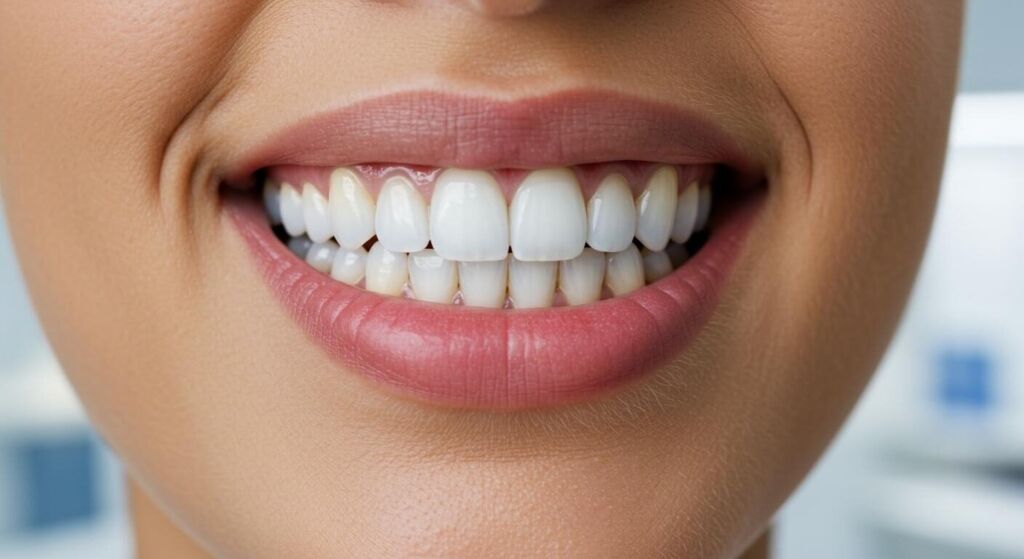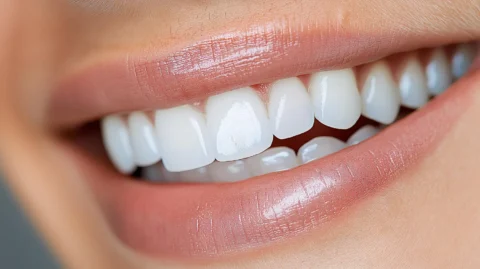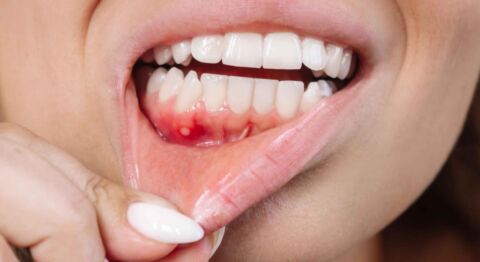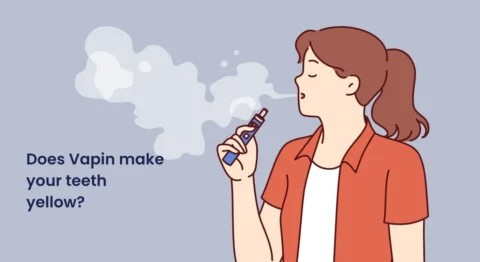You want a whiter, brighter smile without putting your teeth at risk. Whitening strips look like an easy and affordable approach to obtaining results at home, but you might be wondering: Are whitening strips bad for your teeth?
It’s true that whitening strips have both good and bad points. They can make your smile look better and remove stains from the surface, but if you don’t utilize them well, they could pose some problems in the short term. without taking too many risks.
I will discuss the real risks and advantages, the most prevalent side effects, and how to use whitening strips safely in this article. I will also give you dentist-approved options for those who desire long-lasting results
The most common side effects of whitening are temporary tooth sensitivity and moderate gum inflammation. These normally go away when treatment ends. Studies and dental groups agree that whitening strips are safe when used as instructed, but using them too much or incorrectly can raise the dangers. Let’s go over everything in detail so you can choose what’s ideal for your smile.
Table of Contents
ToggleWhat Are Whitening Strips, and How Do They Work?
Whitening strips are thin, flexible pieces of plastic that are covered in a bleaching gel, which is commonly manufactured from hydrogen peroxide or carbamide peroxide.When you put them on your teeth, the gel touches the enamel and starts to break down the molecules that make stains. This technique makes the teeth look whiter and brighter over time.
So, are teeth whitening strips safe? Most studies and professional associations, such as the American Dental Association, agree that they are typically safe when used as advised. The main worries are usually short-term sensitivity or moderate gum inflammation, not harm that lasts.
Here’s a quick look at how whitening strips compare with professional treatments:
- OTC whitening strips commonly include 3% to 10% hydrogen peroxide in them.
- Professional whitening (in-office) can utilize significantly stronger concentrations, usually 15–40% hydrogen peroxide, and is done under the guidance of a dentist for faster results.
This is why a lot of people want to know the difference between whitening strips and professional whitening. Strips are cheaper and easier to use at home, but professional whitening gives faster, more dramatic results with safer supervision.
Whitening strips work best on stains that are on the outside of the teeth, including those from coffee, tea, wine, or smoking. However, they don’t work as well on deeper stains or discoloration that happens on the inside, including from some medications, getting older, or dental damage. In certain circumstances, professional treatments or other cosmetic choices may be better.
Benefits of Whitening Strips
One of the best things about whitening strips is how easy they are to use. You don’t need to go to the dentist or buy expensive equipment. Just put the strips on at home and let the gel do its job. They are also affordable and widely available over the counter (OTC), making them a great beginning step for anyone who wants to make their smile brighter.
So, are whitening strips safe? Yes—they are safe for most people when used as advised. Following the directions on the product and not using it too much is the safest approach to whitening teeth.
Many people get obvious effects from whitening strips in just a few days, and the entire effect usually takes 1 to 2 weeks to show.
They work especially well on stains on the surface of your teeth from coffee, tea, red wine, or smoking. They make your teeth look cleaner and fresher without any effort.
Risks & Side Effects
While whitening strips are effective and safe when used correctly, they are not completely free from risks. The two most common problems are tooth sensitivity and moderate inflammation of the gums. The strength of these side effects varies depending on how much peroxide is in the strips, how long you leave them on, and how often you use them.
Tooth Sensitivity
A lot of people feel sensitive to whitening strips when they are using them.This happens because peroxide gets into the enamel and into the dentin tubules, which have nerve endings in them. Because of this, hot, cold, or sweet meals may make your teeth feel more sensitive. The good news is that sensitivity normally goes away on its own within a few days of stopping medication.
A common concern is, do whitening strips damage enamel? Studies indicate that when utilized according to instructions, strips do not inflict lasting damage to enamel. Most of the time, problems happen when you use something too much or for too long.
Gum/Soft Tissue Irritation
If you don’t put the strips on carefully, the peroxide gel can touch the gums or other soft tissues, which can cause irritation, burns, or redness. Using it too much raises this risk. If you feel mild or severe discomfort, it’s recommended to cease treatment and allow the tissues to heal before attempting again.
Enamel & Restorative Materials
Using whitening strips for a long time or in a way that isn’t specific to your needs can change the surface of enamel or damage restorations like fillings, crowns, or veneers. Restorations don’t whiten like real teeth; thus, the colors can be off. Before using whitening strips more than once or for a long time, you should see a dentist.
Who Should Avoid or See a Dentist First
Certain groups should consult a dentist before using whitening strips. These include:
- Children and teens under 18
- Pregnant or breastfeeding women
- Anyone with untreated cavities or active decay
- People with large restorations or crowns on front teeth
- Those with severe gum disease or enamel defects
In short, whitening strips are safe for most people, but you should be careful and use them correctly to avoid unnecessary risks.
Pro Tip
Take breaks between whitening cycles—constant use won’t speed up results but can increase sensitivity.
How to Use Whitening Strips Safely
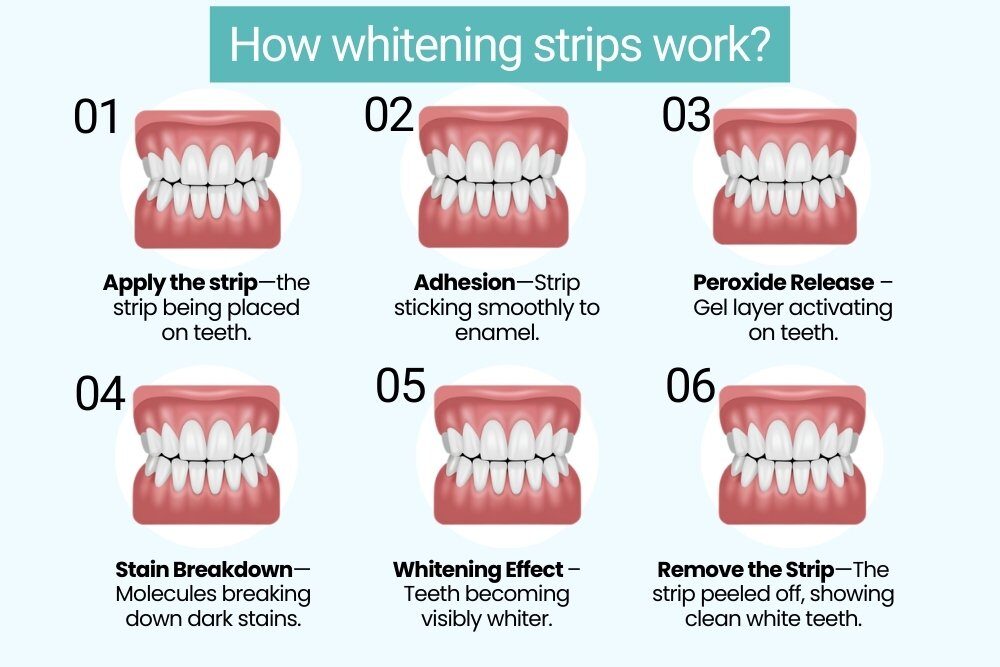
If you apply whitening strips the right way, they can make your smile brighter without hurting your teeth. The most important thing is to follow the directions carefully and not take any shortcuts. So, are teeth whitening strips safe? Yes—but only if you use them as intended.
Here’s a step-by-step guide to help you do it right:
- First, read the instructions from the maker.Each brand has its own set of rules on when and how often to apply.
- Before you use it, brush and floss.A clean surface makes sure that the whitening gel touches the enamel directly.
- Be careful when you put the strips down. Put them in line with your teeth and press down softly. Don’t let the gel touch your gums too much.
- Follow the suggested frequency and length. Don’t wear strips for longer than the prescribed time, and don’t use more strips than the authorized amount each day. For example, Crest warns against using more than what it says to do each day.
- Keep an eye on how sensitive you are. Take a pause if you start to feel uncomfortable. Use a sensitivity toothpaste that has potassium nitrate or fluoride in it. These ingredients help relax the nerves in your teeth.
- Consult your dentist if needed. Especially if you have dental work done, are already sensitive, or don’t know if it’s safe to use.
Many people also ask, how often can you use whitening strips? Most products are meant to be used every day for a short time (usually one to two weeks), and then you should take a significant rest before using them again. Using strips too regularly can make your gums and enamel more sensitive and irritated.
By following these steps, you can safely enjoy a brighter smile while keeping your teeth and gums healthy.
Pro Tip
Use a straw for coffee/tea to avoid new stains during whitening.
Don’t brush immediately after removing strips—wait 30 minutes to protect enamel.
Whitening Strips vs Professional Whitening
A lot of individuals compare whitening strips vs. professional whitening. when it comes to making their smiles look better. Both approaches work, but it’s crucial to know how they differ in terms of strength, safety, and results.
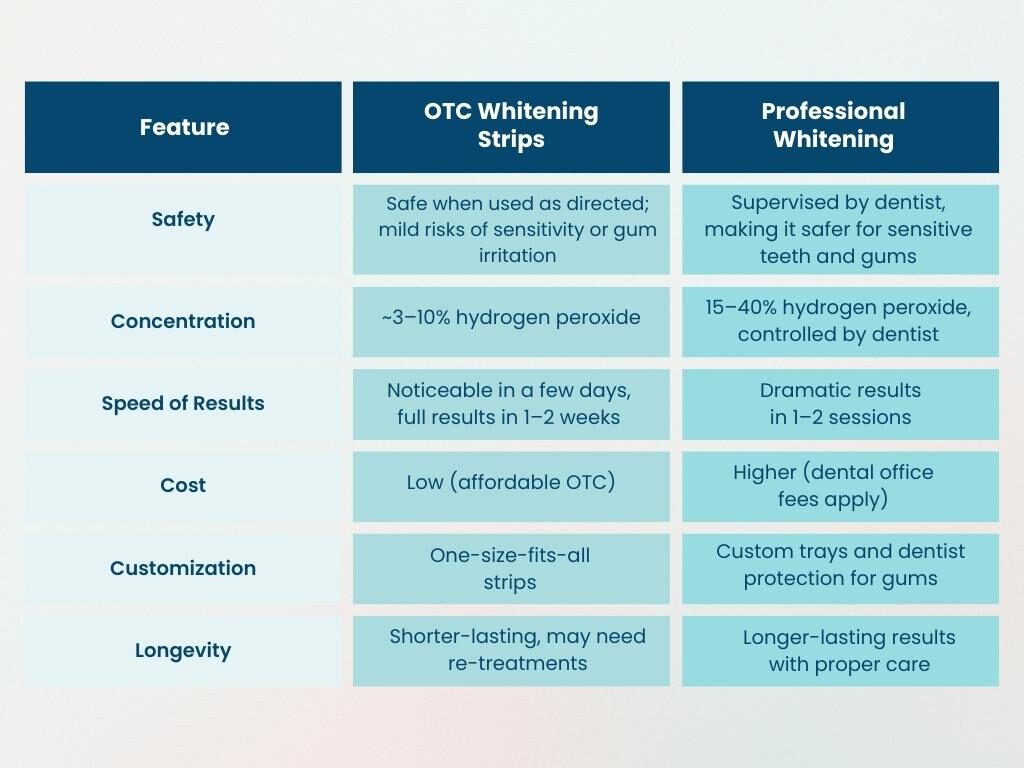
Dentists typically suggest professional treatments for patients who have deeper or more permanent stains or who want outcomes that are faster and more even. Strips are easy to use and cheap, but if you want long-lasting results, professional whitening is one of the best options and is suggested by dentists.
Pro Tip
If you want fast results before an event, professional whitening works best. For gradual brightening, strips are affordable and effective.
Safe Alternatives & Dentist-Recommended Options
Dentists say there are a few safest ways to whiten teeth that have been shown to work. In-office whitening is the fastest way to whiten teeth. A dentist uses a stronger gel under professional supervision. This makes sure that it is safe, works quickly, and lowers the chance of gum discomfort. Custom take-home trays are another good choice. They give you even coverage and controlled concentrations, so you may slowly whiten your teeth at home with help.
For mild surface stains, whitening toothpaste and rinses can help, but they don’t work as well on deeper enamel layers. These are often ideal for keeping your teeth white after a professional whitening.
Some people explore “natural” or non-peroxide whitening products. Vogue and other lifestyle magazines like them, but research shows that they don’t work very well in the long term. If you want to try them, pick well-known brands and talk to your dentist first to be sure the substances aren’t too harsh or haven’t been tested.
According to the ADA and expert dentists, dentist-supervised methods remain the most reliable dentist-recommended whitening alternatives, balancing safety, results, and long-term oral health.
Pro Tip
Always get a dental checkup before choosing whitening — untreated cavities or gum issues can make whitening painful or unsafe.
Practical Tips to Reduce Sensitivity & Protect Enamel During Whitening
Before and after treatments, use a toothpaste that doesn’t cause sensitivity (potassium nitrate or fluoride).
- Don’t wear or use the product more often than recommended.
- Don’t eat or drink anything that is particularly acidic or stains your teeth (such as coffee, tea, wine, or soda) for at least 48 hours after whitening. Use a soft-bristled toothbrush to brush gently so you don’t wear down your enamel more.
- If you start to feel sensitive, take small intervals between whitening cycles. To make the enamel stronger, rinse with a fluoride mouthwash.
- Don’t mix strips with other whitening products unless your dentist says it’s okay.
- If you have restorations like fillings, veneers, or crowns, talk to your dentist about how safe they are and how well they fit your teeth.
Pro Tip
If you want fast results before an event, professional whitening works best. For gradual brightening, strips are affordable and effective.
Conclusion & Dentist’s Final Advice
Whitening strips can help make your smile seem better quickly and easily, but they do come with some risks. The most common adverse effects include sensitive teeth and irritated gums, especially if the strips are used too often or not correctly. Always follow the manufacturer’s instructions, and if you start to feel pain, take a break. Don’t do the same thing over and over again without professional help.
Talk to your dentist first if you want safe, long-lasting results or if you want your teeth to be even whiter. They can help you choose the ideal way to whiten your teeth, whether it’s with professional supervision, bespoke trays, or safer solutions at home.
FAQ-Whitening Strips Safety and Use
Are whitening strips bad for your teeth?
Yes, when used as directed, whitening strips are generally safe. The most common side effects are temporary tooth sensitivity and mild gum irritation.
Do whitening strips damage enamel?
No, not when used correctly. Overuse of products with very high peroxide levels can increase risk, so consult a dentist before repeated courses.
Can I use whitening strips with sensitive teeth?
Yes, but choose low-strength products and use desensitizing toothpaste. If sensitivity worsens, pause treatment and see your dentist for safer alternatives.
How often can I use whitening strips?
Always follow product instructions. A standard course is once daily for 1–2 weeks, with optional maintenance treatments every 3–6 months.
Are whitening strips as good as professional whitening?
Whitening strips can brighten surface stains but are less powerful than dentist-supervised treatments, which use higher peroxide concentrations and custom trays for longer-lasting results. Drink plenty of water. Saliva protects enamel during whitening.

